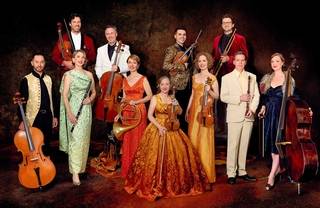|
Back
18th Century Uncovered New York
Weill Recital Hall, Carnegie Hall
10/16/2023 - & October 13 (San Diego), 14 (Orange County), 18 (Morristown), 20 (Annapolis), 21 (Columbia, MD), 2023
Johann Christian Bach: Symphony in G Minor, Opus 6, No. 6
Joseph Haydn: Symphonies No. 6 in D Major, “Le Matin”, & No. 8 in G Major, “Le Soir”
Wolfgang Amadeus Mozart: Symphony No. 29 in A Major, K. 186a [201]
Australian Haydn Ensemble, Skye McIntosh (Artistic Director/Concertmaster)

Australian Haydn Ensemble
“Music is the art of the prophets, the only art that can calm the agitations of the soul; it is one of the most magnificent and delightful presents God has given us.”
Johann Christian Bach
“Being Music-Master at Esterházy Palace, I was cut off from the world. Nobody was around to confuse or torment me. Thus, I was forced to become original.”
Joseph Haydn
Weill Recital Hall was almost–almost!–the ideal setting for the Australian Haydn Ensemble tonight. The 18‑member ensemble was Haydn/Mozart‑sized. The period‑style instruments, despite a few fluffs and long tuning up, was excellent. The Recital Hall itself has the elegance of an 18th Century salon, with Belle Epoch decor, the 300‑odd seats offering becoming intimacy.
What, then, went wrong? Simply a sin of omission. Some un‑enterprising soul should have taken down the myriad bulbs of the glittering three chandeliers–and replaced them with a myriad of tapered candles. For a concert of late 18th Century music, Louis XV, Marie‑Antoinette and Prince Nicholas Esterházy would have expected nothing less.
Still, the chandeliers notwithstanding, the Australian Haydn Ensemble augmented this exotic October with a Lithuanian conductor, and a Kazakhstan orchestra. One wouldn’t want to embarrass this group by reminding them that when Haydn, Mozart and J.C. Bach were writing, their country was simply a penal colony for wicked Britishers.
These players, though, embracing an almost-all-female string section, with gorgeous winds and with dynamic conducting by their founder, led three iconic composers of the 18th Century with vigor and–often–enlightenment.
That vigor and the unexpected emotion, started with Johann Christian Bach’s G Minor Sympony. Not only the emotion but the sheer contrast to J.S. Bach was noticeable. Didn’t J.S. teach his son counterpoint? One rarely heard it here. But one did hear a intensity in the first movement, a melodic (and somewhat prolonged) second movement and a finale which smacked of Sturm und Drang.
Today, J.C. Bach is usually thrown in with P.D.Q. Bach, but that is unfair. In his time, he was as beloved in London as Handel. Both Mozart and Haydn admired him. And in a world where J.S. Bach was considered archaic, J.C. was a star of all Europe.
(Unlike his elder brother, Wilhelm Friedemann Bach, a drunkard who fell off countless organ seats, and whose daughter emigrated to–wait for it–Oklahoma.)
That was a good enough symphony. But the Australian Haydn Ensemble came into their orchestral own with the two early Haydn symphonies.

J. Haydn/J. C. Bach (painting by Thomas Gainsborough)
Haydn obviously had a good time with both “Le Matin” and “Le Soir”. His tiny Esterházy orchestra had some amazing soloists. And because the players all were confined to two tiny rooms in the Palace garden, they not only improved their skill (nothing else for the “hired help” to do), but Haydn wanted to give each of the soloists some great moments.
And were they great here! Melissa Farrow might have been playing a “period” flute, but her frequent solos–frequent exciting scales, echoes of the orchestra, Haydn whimsy–were glittering and radiant. Then we come to Haydn writing a kind of Concerto for Orchestra. Not only Ms. Farrow’s flute but, in “Le Matin” an echoing duet between Ms. McIntosh’s solo violin and Daniel Yeadon’s solo cello.
Add to this oboes and bassoon (a solo in “Le Soir”). Since I’ve never heard this live, I never realized that in the G Major Symphony menuet, he wrote a long long solo for double bass. Pippa Macmillan did the honors.
The Mozart 29th Symphony is always a joy to hear. And Ms. McIntosh led the group well. Understandably, with their resources, the Mozart sounded lightweight. Unlike the Haydn, this piece deserves a full symphonic band. Last night, the clarity was outstanding. Yet one missed the strength of full symphony orchestra.
After, this writer inevitably reflected on both these young composers, I imagined Haydn taking unalloyed delight as he penned his paper, using his imagination to show off his favorite musicians. Mozart, one feels, never felt either delight or human imagination. In between his billiard and prurient jokes, he would sit down and become his music. The feelings in the notes, not the mind.
That could all be fallacious. Not false, though, was the Australian Haydn Ensemble joy and expertise. This is their first American presence. Let it not be the end. Haydn’s 100‑plus symphonies deserve more from this chamber‑sized radiant assemblage.
Harry Rolnick
|